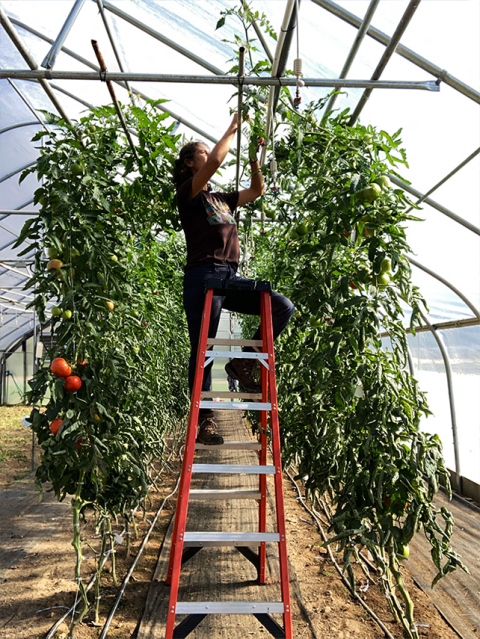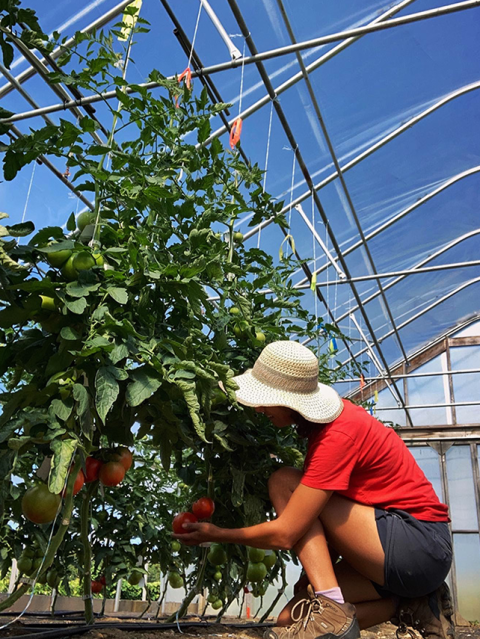Key Findings

Cluster pruning increased fruit size but did not increase marketable fruit yield.
Cluster pruning treatments increased cracking. Environmental factors, including irrigation scheduling and daily temperature fluctuations, likely also played a role in the cracking.
Vegetative growth significantly increased by reducing fruit load. However, this did not correlate to greater yields and additional labor was required for trellising and sucker removal.
Study results thus far do not suggest that removing alternate fruit clusters is beneficial.
About the Co-Author

Becky Sideman, professor, Agriculture, Nutrition, and Food Systems; follow the UNH Sideman Lab on Instagram, UNH Sideman Lab website
Contact information: Becky.Sideman@unh.edu, 603-862-3203
This research was published in the INSPIRED: A Publication of the New Hampshire Agricultural Experiment Station (Summer 2022)
Researchers: C. Roman and B. Sideman
Different varieties of tomatoes with season-long harvest periods are commonly grown in high-tunnel structures throughout the world. However, many tomato varieties suffer from a phenomenon called ‘June drop’ in which a plant's first four to five fruit clusters set perfectly, but the subsequent two to three clusters set poorly and the plant's productivity suddenly drops. This may occur due to the excessive demand for resources by the already-set fruit. Reducing fruit load early in the season could prevent this productivity drop. This research examined the impact of thinning and removing tomato fruit clusters on fruit weight, total marketable yields, prevalence of defects and season-long fruit production.
Planting and growing in high tunnels
In May 2021, Big Beef (Johnny's Selected Seeds of Albion, ME) tomato seeds were sown in seedling strip trays containing PRO-MIX BX in a heated greenhouse and fertigated (fertilized and irrigated) with 17-4-17 at 100 parts per million (ppm) N. After germination, seedlings were transplanted into 606 trays and received 17-4-17 fertilizer at 150 ppm N until transplanting.
The high tunnel was prepared by broadforking and then applying soybean meal and sul po mag to provide 100 pounds per acre (lbs/acre) of nitrogen (N) and 145 lbs/acre potash. Plants were spaced 18 inches apart in two rows located 6 feet apart. Two strands of drip irrigation tape were laid per row. Black plastic landscape fabric was installed between the rows to mitigate weed pressure. In May 2021, the tomato seedlings were transplanted into the high tunnel and a tomato clip was used to trellis each plant to a single strand of tomato trellising twine in a single-leader pruning system.
Sucker and cluster pruning was performed once a week throughout the season. Additional tomato clips were added every 1-2 weeks to trellis the plants. Bottom leaves were removed below the first fruit cluster and subsequently below the lowest remaining fruit cluster. Fruit cluster pruning treatments consisted of a control (no fruit pruned), 6 (six fruit per cluster), 3 (three fruit per cluster), 6A (every other cluster removed and six fruit per remaining cluster) and 3A (every other cluster removed and three fruit per remaining cluster).
The five treatments were applied in a randomized complete block design with 12 blocks and a single plant representing an experimental unit.
Harvesting, collecting samples and managing pests
Fruit removal for cluster thinning occurred after the flowers had set, when fruit was approximately marble-sized. All ripe fruit were harvested weekly from July through November. Each fruit was weighed, graded for size using U.S. Department of Agriculture guidelines and observed for deformities that would result in them being unmarketable (i.e., cracking, uneven ripening, yellow shoulder or smaller than U.S. grade small). Plant height and stem diameter were measured three times during the season.
The insecticide Bacillus thuringiensis (DiPel DF, Valent Biosciences) was applied once mid-season for tomato hornworm. On July 1, plants were side-dressed at a rate of approximately 120 lbs/acre of N and 200 lbs/acre of potash by applying soybean meal and sul po mag at the base of each plant. High tunnel sides were left open unless it was raining or the night temperature was below 55°F. Irrigation was applied based on the amount of soil moisture using the touch method and generally followed a schedule of watering one hour every other day and increasing this frequency during hot, dry periods and decreasing this frequency during rainy weather.
Research results
Total yield and fruit deformity impact. Total yields varied by pruning treatment (Table 1). Treatment 6 plants produced the greatest total yields, averaging 8,321 grams (g) per plant over the entire season. Plants with treatment 3A produced yields significantly lower than all other treatments, averaging 4,256 g per plant. The most prevalent deformity in all treatments was fruit cracking, particularly radial cracking originating from the stem scar, followed by uneven ripening of fruit. Treatment 3A had the highest percentage of unmarketable fruit, whereas treatment 6 had the lowest rate at 37 percent. These results were unexpected relative to the hypothesis that cluster pruning would decrease the fruit cull rate.
Individual fruit weight. Cluster pruning treatments had a significant effect on fruit size (Table 1). The pruning treatment 3A resulted in the largest fruit. Treatments 6 and the control had the smallest fruit, and treatments 3 and 6A had intermediate-sized fruit. Regardless of treatment, almost all fruit still fell into the medium, large or extra-large size categories. The larger fruit present in 3A plants seemed to correspond with higher rates of fruit cracking, which led to greater amounts of the 3A fruit being deemed unmarketable.


Many tomato varieties suffer from a phenomenon called ‘June drop’ in which a plant's first four to five fruit clusters set perfectly.

Pruning effect on production throughout the season. Across treatments, clusters rarely set more than five fruits (Figure 1). We hypothesized that cluster pruning would maintain productivity throughout the season by altering the ratio of photosynthesizing vegetative growth to carbohydrate sinks (fruit). In the control (unpruned) plants and in plants pruned to 6 fruit per cluster, yields began very high and dropped steadily throughout the season. In 3A plants, yields were low and steady throughout the season and cumulative yields did not reach those of other treatments. Treatments 3 and 6A showed intermediate performance; they started out with lower yields than the control plants but produced higher yields later in the season.
After the first four clusters, the control and 6 plants set fewer and smaller fruits. On the control plants, this was most apparent at the 5th and 6th clusters, with an average of only 2.8 and 2.7 fruits per cluster (Figure 2). In some cases, the cluster only produced three flowers; in others, several flowers aborted before fruit set. Many pollinators were present inside the high tunnel, suggesting that flower termination was not due to a lack of pollination.
Vegetative growth and nutrient utilization. Plants receiving treatments 3A and 6A were visibly greener and the leaves were thicker along with their increased height and stem diameters. These findings suggest that aggressive fruit pruning changes the source/sink relationship of vegetative growth to fruit production. While an adequate amount of vegetative growth is needed to photosynthesize, excess growth may be a waste of plant productivity.
Vegetative growth and nutrient utilization. Plants receiving treatments 3A and 6A were visibly greener and the leaves were thicker along with their increased height and stem diameters. These findings suggest that aggressive fruit pruning changes the source/sink relationship of vegetative growth to fruit production. While an adequate amount of vegetative growth is needed to photosynthesize, excess growth may be a waste of plant productivity.